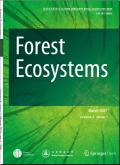Lifespan of tropical trees from seed to 1-cm diameter
IF 4.4
1区 农林科学
Q1 FORESTRY
引用次数: 0
Abstract
Background
The full lifespan of long-lived trees includes a seedling phase, during which a seed germinates and grows to a size large enough to be measured in forest inventories. Seedling populations are usually studied separately from adult trees, and the seedling lifespan, from seed to sapling, is poorly known. In the 50-ha Barro Colorado forest plot, we started intensive censuses of seeds and seedlings in 1994 in order to merge seedling and adult demography and document complete lifespans.
Methods
In 17 species abundant in seedling censuses, we subdivided populations into six size classes from seed to 1 cm dbh, including seeds plus five seedling stages. The smallest seedling class was subdivided by age. Censuses in two consecutive years provided transition matrices describing the probability that a seedling in one stage moved to another one year later. For each species, we averaged the transition matrix across 25 censuses and used it to project the seedling lifespan, from seed until 1 cm dbh or death.
Results
The predicted mean survival rate of seeds to 1 cm dbh varied 1000-fold across species, from 2.9 × 10−6 to 4.4 × 10−3; the median was 2.0 × 10−4. The seedling lifespan, or the average time it takes a seed to grow to 1 cm dbh, varied across species from 5.1 to 53.1 years, with a median of 20.3 years. In the median species, the 10% fastest-growing seeds would reach 1 cm dbh in 9.0 years, and the slowest 10% in 34.6 years.
Conclusions
Combining seedling results with our previous study of lifespan after 1 cm dbh, we estimate that the focal species have full lifespans varying from 41 years in a gap-demanding pioneer to 320 years in one shade-tolerant species. Lifetime demography can contribute precise survival rates and lifespans to forestry models.
热带树木从种子到直径1厘米的寿命
长寿树木的整个生命周期包括一个幼苗期,在此期间种子发芽并生长到足够大的尺寸,以便在森林清查中进行测量。幼苗种群通常与成树分开研究,而从种子到树苗的幼苗寿命鲜为人知。在50公顷的Barro Colorado森林地块,我们于1994年开始对种子和幼苗进行密集的普查,以便将幼苗和成年人口统计结合起来,并记录完整的寿命。方法将幼苗普查中数量较多的17种植物,从种子到1 cm dbh,分为6个大小级,包括种子和5个苗期。最小的幼苗类按年龄细分。连续两年的人口普查提供了过渡矩阵,描述了一年后一个阶段的幼苗转移到另一个阶段的概率。对于每个物种,我们在25次普查中取过渡矩阵的平均值,并用它来预测幼苗的寿命,从种子到1cm dbh或死亡。结果预测种子在1cm dbh内的平均存活率在2.9 × 10−6 ~ 4.4 × 10−3之间,差异达1000倍;中位数为2.0 × 10−4。幼苗寿命,即种子生长到1厘米每小时所需的平均时间,在不同物种之间从5.1年到53.1年不等,中位数为20.3年。在中位数树种中,生长最快的10%种子在9.0年达到1 cm dbh,生长最慢的10%种子在34.6年达到1 cm dbh。结论结合幼苗结果和我们之前对1 cm dbh后寿命的研究,我们估计焦点物种的完整寿命从需要间隙的先锋物种的41年到一个耐荫物种的320年不等。终生人口统计可以为林业模型提供精确的存活率和寿命。
本文章由计算机程序翻译,如有差异,请以英文原文为准。
求助全文
约1分钟内获得全文
求助全文
来源期刊

Forest Ecosystems
Environmental Science-Nature and Landscape Conservation
CiteScore
7.10
自引率
4.90%
发文量
1115
审稿时长
22 days
期刊介绍:
Forest Ecosystems is an open access, peer-reviewed journal publishing scientific communications from any discipline that can provide interesting contributions about the structure and dynamics of "natural" and "domesticated" forest ecosystems, and their services to people. The journal welcomes innovative science as well as application oriented work that will enhance understanding of woody plant communities. Very specific studies are welcome if they are part of a thematic series that provides some holistic perspective that is of general interest.
 求助内容:
求助内容: 应助结果提醒方式:
应助结果提醒方式:


